This group wanted to take over the fairgrounds. But then they ran into the fair board
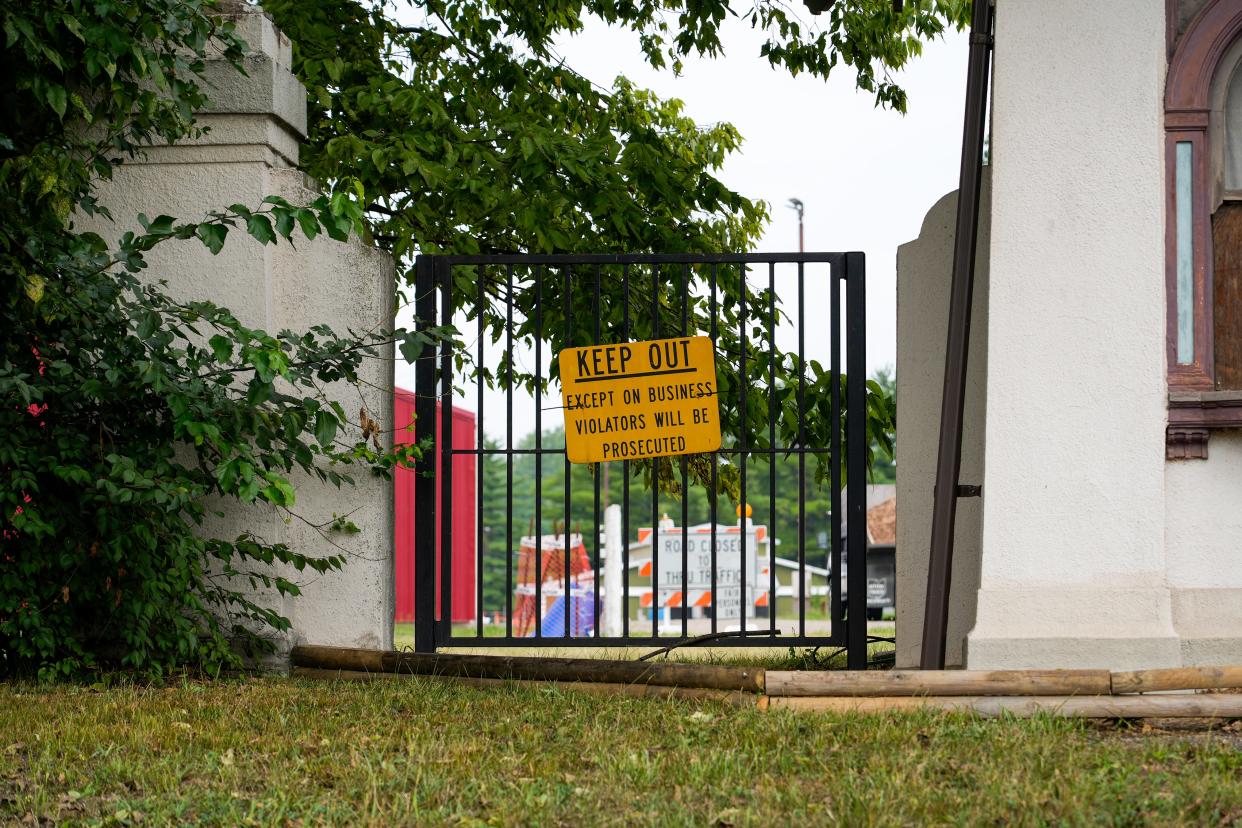
The small crew at the Cincinnati Recycling and Reuse Hub had grand plans for the Hamilton County Fairgrounds.
The nonprofit wanted to move its recycling center from Lower Price Hill to the 37-acre fair site and surround it with nature trails, community gardens and a home for more than 20 organizations devoted to fighting climate change and preserving the environment.
They even had a plan to take over the board that has governed the fairgrounds in Cincinnati's Carthage neighborhood for more than 160 years, the Hamilton County Agricultural Society. They didn't succeed.
The fight over the Hamilton County Fairgrounds once again raised the decades-old question: what is the future of the beleaguered 168-year-old fair and the land it controls?
The Hamilton County Fair's new leadership said the fair isn't going anywhere. They still hope to turn it around, beginning with the 2023 fair, which begins Aug. 10.
"We want to continue to have the fair," said Crystal Holthaus, president of the Hamilton County Agricultural Society Board. Holthaus, 36, a resident of Reading, joined the agricultural society in 2019 and became its president in 2022. She grew up going to the fair and wants to keep it alive. "We've been there for 168 years. Many have tried and many have failed to take over the fairgrounds. And that's because you get the people that are passionate about it that will fight for it."
A tense back and forth with the agricultural society led the recycling center to abandon the plans, as have so many who have also proposed something for the fairgrounds over the past century-and-a-half.
"It's very disappointing," said Colleen McSwiggin, executive director and "recycler-in-chief" of the Cincinnati Recycling and Reuse Hub. "Just because it could be so much more, but the agricultural society has dug in their heels and really closed that option to anybody else."
For you see, legally, the Hamilton County Fair is "forever."
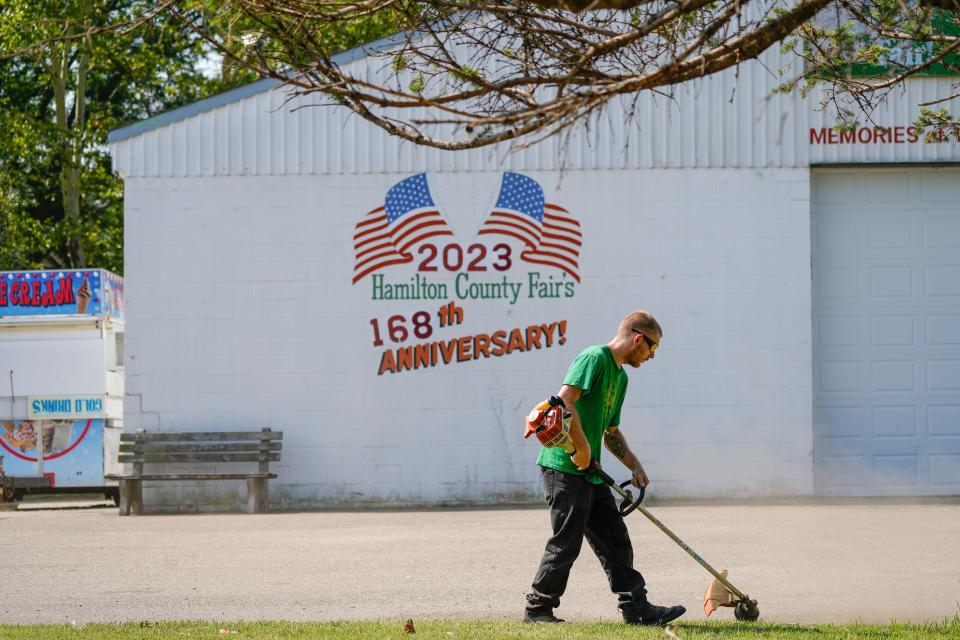
What keeps the fair going? It goes back to the Civil War
The 168th Hamilton County Fair will take place Aug. 10-13. But it's not popularity that keeps the fair going. Attendance has dwindled from 75,000 in the mid-1990s to 5,500 in 2019 and 14,000 in 2021, the most recent figures available from the agricultural society's filings with the Ohio Department of Agriculture.
Rather, the fair continues in Carthage due to a decision by the Hamilton County commissioners during the Civil War. In 1862, the commissioners gave the agricultural society a lease on the fairgrounds "forever" as long as the society exists and has a fair.
A lot has changed in Carthage since the Civil War. The farmlands have given way to car lots, auto repair shops, White Castles and Speedways in the neighborhood a few miles north of Downtown Cincinnati. Interstate 75 runs right by the fairgrounds.
A barbed wire fence circles the fairgrounds, "Keep Out" signs affixed on the weathered chainlink. It feels more like an impound lot than an agrarian fair.
A decades-old dilemma
People have proposed different uses for the land for more than a half-century. In the early 1960s, Hamilton County commissioners wanted to sell the land for industrial use.
"It's impossible to justify the use of a highly desirable 40-acre industrial tract of land for a four-day event," then-County Commissioner Joseph DeCourcy told The Enquirer in 1964.
It didn't matter. The agricultural society didn't budge.
Hamilton County gets about one inquiry a year from people in the real estate business asking about the availability of the fairgrounds for some other purpose, said Holly Christmann, assistant Hamilton County administrator.
"We always go back to the perpetual lease," Christmann said.
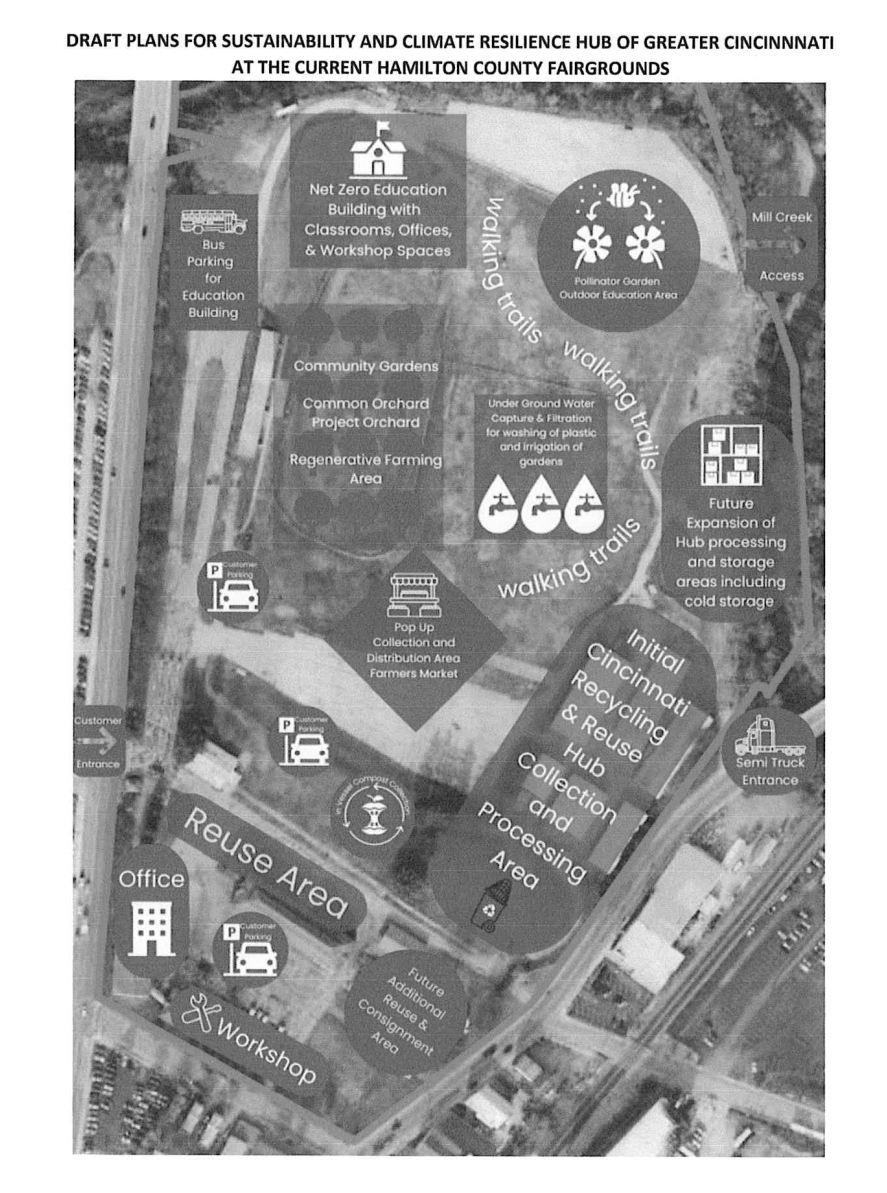
That brings us to this year when a small group of recyclers set their sights on the fairgrounds. The Cincinnati Recycling and Reuse Hub has outgrown its red brick warehouse in Lower Price Hill.
The hub takes in what others won't, its executive director, McSwiggin, said. People fill the parking lot to drop off serving trays, dishes, plastics, electronics, binders, office supplies and hundreds of other items they have no use for but hope someone else will.
The operation started in April 2021 and has recycled 250 tons of materials since then. The organization doesn't do most of the recycling on-site but serves as a hub where the material is sent to other organizations that do the recycling. The hub has a floor of tiles, office supplies, utensils and a variety of supplies that people can shop for free and take for reuse.
Their current warehouse, a 100-year-old building that survived the 1937 flood, is tucked away among a maze of warehouses.
They wanted a bigger place, visible from a major highway with room for dozens of programs and organizations, McSwiggin said. The fairgrounds seemed perfect. They hoped to get the Carthage community on board.
Hostile takeover?
McSwiggin reached out to Hamilton County Commissioner Denise Driehaus. She emailed Driehaus her organization's plan in April to create a "Sustainability and Climate Resistance Hub" at the fairgrounds, public records show.
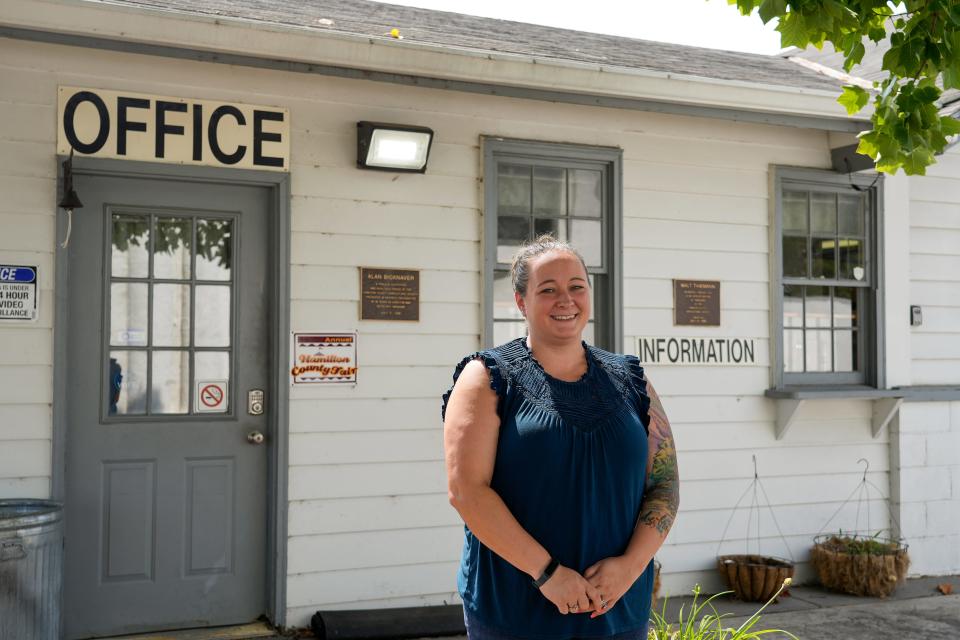
She envisioned it as a one-stop shop for ecologically-friendly organizations. The hub would have put more than 20 environmental groups on the property, have educational space to teach about environmentally friendly practices and offer community gardens and walking trails.
Driehaus responded in an email politely but didn't commit to any position, just saying "it was great to see your operation firsthand."
Just one problem with the plan: that perpetual lease. McSwiggin thought she had a novel way to get around that: get enough people to join the Hamilton County Agricultural Society, vote new members on the 11-member board, who would then vote the society out of business. The group then could renegotiate a lease with the county commissioners for the fairgrounds that would require the fairgrounds to be used for sustainability purposes and have a certain amount of green space.
The recycling center hoped to get the public on their side, McSwiggin said.
"It is time for Hamilton County residents to take it back and put it to better use."
The agricultural society has 50 to 100 members (the society couldn't give a specific number when asked by The Enquirer) who vote on a board of directors every November. To join the agricultural society, you have to live in Hamilton County and pay a fee of $30.
The Hamilton County Agricultural Society and McSwiggin disagree on what happened next.
McSwiggin said she approached the agricultural society with her plan and was rebuffed. The agricultural society's president, Holthaus, said McSwiggin went behind their backs and tried to get sponsors to pull out of the fair.
"Had she come to us with anything, we would have been more open," Holthaus said. "As opposed to her going after our sponsors and going after our funding."
McSwiggin said she emailed one sponsor, a bank, to let them know the society was no longer a nonprofit and donations wouldn't be tax-deductible.
McSwiggin said the fair board threatened legal action. In any event, the board of the Cincinnati Recycling and Reuse Center felt the whole thing wasn't worth the trouble and abandoned the plans to pursue the fairgrounds.
"They've got an ironclad lease," McSwiggin said. "They were not interested in working with us and collaborating."
So what is the future?
Now that the takeover plan fizzled, the fair hopes to start turning things around, Holthaus said. They've set the goal of 35,000 people in attendance this year.
"If we can hit 35,000, we will be able to do a whole lot more next year," Holthaus said. "My fingers crossed we supersede that number."
When asked about how they'd reach that goal, Holthaus said they have more musical acts this year, a large cornhole tournament, a zipline and other attractions.
An attendance of 35,000 people this year would be a remarkable turnaround.
In 2020, the Hamilton County Board of Commissioners, concerned over the plight of the fair, assembled a task force of community leaders to make recommendations. If nothing changes, the fair has a "two-to-three-year horizon to ride or die," Kathleen Norris, a real estate consultant and member of the Hamilton County Fair Task Force, said in 2020.
As attendance plummeted, the Hamilton County 4-H left the county fair in 2010 to start its own community fair, held in late June and early July at Stricker's Grove. That took a bulk of the livestock events away from the fair.
The IRS revoked the fair's nonprofit status in 2014 for failure to file the proper form. The agricultural society still has yet to regain its nonprofit designation.
Ohio Auditor Keith Faber in 2019 declared the fair's finances so poorly run they were "unauditable." An audit released in May for the years 2019-2021 didn't show much improvement, with the auditor criticizing the agricultural society on a variety of issues, including financial reports filed in 2019, 2020 and 2021 that were "incomplete, inaccurate and did not note disclosures."
Holthaus said the agricultural society's finances and relationship with the auditor is improving.
"Everything is very much better handled," Holthaus said. "We have a relationship with a state auditor. And every time they give us any type of suggestions, we try to implement them."
How does the fair board get its money?
Hamilton County government gives the fairgrounds $3,200 a year, the minimum required by Ohio law for counties to give to the local agricultural society. The fair also received a $50,000 state grant in 2020. This fair board, in a statement to The Enquirer in 2021, said it used the money to buy picnic tables for a beer garden, new doors, windows and LED lighting for a buildings and other cosmetic improvements.
But a majority of the fair revenue comes from admissions and rental of the fairgrounds, according to the most recent financial reports from the agricultural society.
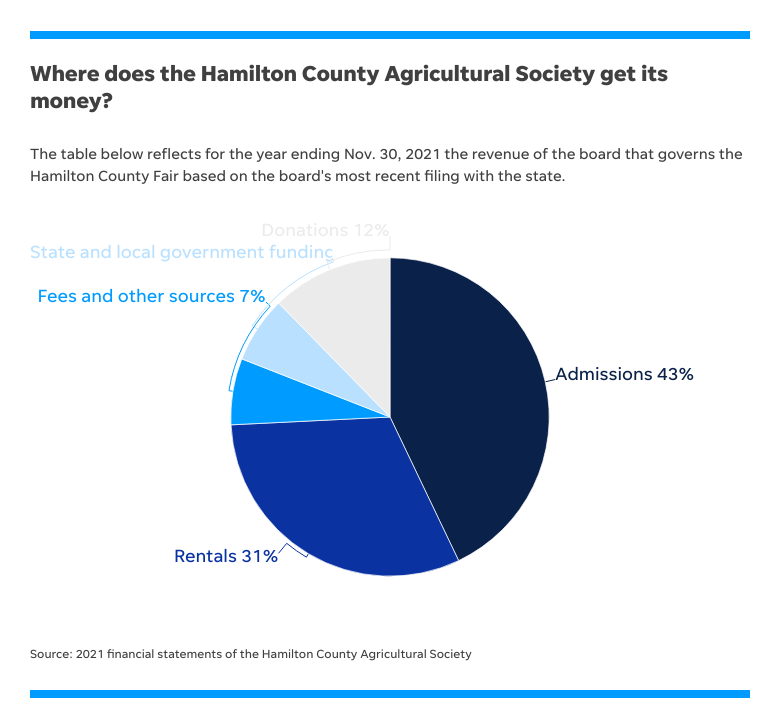
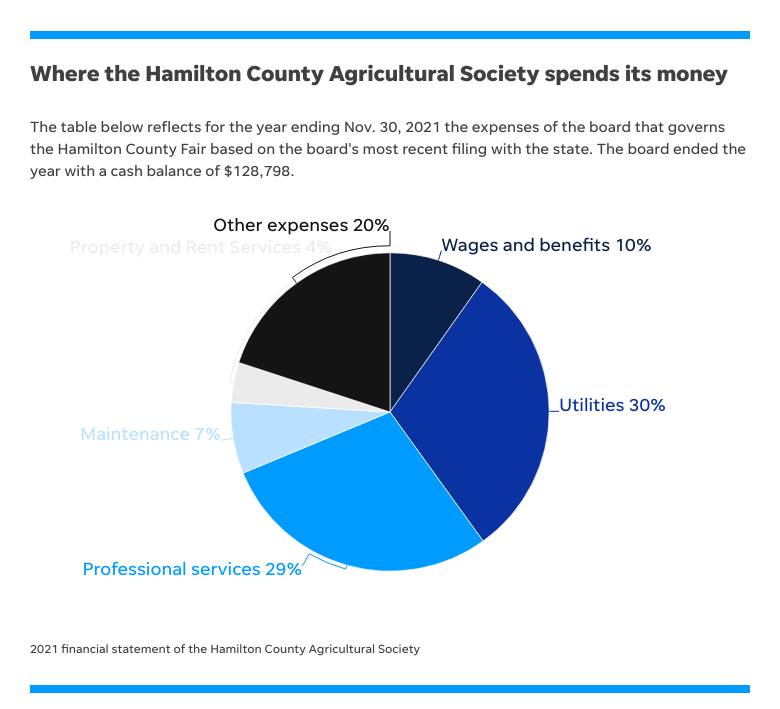
What do residents want?
While the fair has diminished and had issues, some Carthage residents who talked to The Enquirer want it to remain a fairground. Sandy Jacobs, 76, of Carthage has volunteered at the fair for years, selling tickets, working security, answering phones and performing any odd jobs that need doing.
"It’s everything," Jacobs said. "For one, if they don’t have a fair and that property goes vacant, who knows what we’re going to get up there? I don’t want a sewer plant up there, I don’t want recycling."
Rick Ward has lived in Carthage for all 67 years of his life. He smiled when he recalled one of his favorite attractions at the fair, a troupe of stunt drivers called the Hurricane Helldrivers, who would drive up on two wheels. He misses the fairs of old, he said.
"It doesn't mean as much as it used to," said Ward. "We don't have as much attractions anymore ... It's just not what it used to be."
If you go
What: The Hamilton County Fair
When: Aug. 10-13
Where: Hamilton County Fairgrounds, 7801 Anthony Wayne Ave., Cincinnati, Ohio.
Cost: Admission, $7; ride wristbands, $10; parking, $5; zip line, $10.
For more information, www.hamiltoncountyfair.com.
.
This article originally appeared on Cincinnati Enquirer: Hamilton County Fair: What happened to plans to reuse the fairgrounds?

